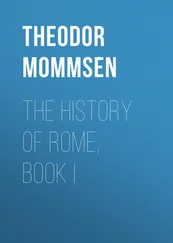Theodor Mommsen - The History of Rome. Book III
Здесь есть возможность читать онлайн «Theodor Mommsen - The History of Rome. Book III» весь текст электронной книги совершенно бесплатно (целиком полную версию без сокращений). В некоторых случаях можно слушать аудио, скачать через торрент в формате fb2 и присутствует краткое содержание. Жанр: История, Культурология, на английском языке. Описание произведения, (предисловие) а так же отзывы посетителей доступны на портале библиотеки ЛибКат.
- Название:The History of Rome. Book III
- Автор:
- Жанр:
- Год:неизвестен
- ISBN:нет данных
- Рейтинг книги:5 / 5. Голосов: 1
-
Избранное:Добавить в избранное
- Отзывы:
-
Ваша оценка:
- 100
- 1
- 2
- 3
- 4
- 5
The History of Rome. Book III: краткое содержание, описание и аннотация
Предлагаем к чтению аннотацию, описание, краткое содержание или предисловие (зависит от того, что написал сам автор книги «The History of Rome. Book III»). Если вы не нашли необходимую информацию о книге — напишите в комментариях, мы постараемся отыскать её.
The History of Rome. Book III — читать онлайн бесплатно полную книгу (весь текст) целиком
Ниже представлен текст книги, разбитый по страницам. Система сохранения места последней прочитанной страницы, позволяет с удобством читать онлайн бесплатно книгу «The History of Rome. Book III», без необходимости каждый раз заново искать на чём Вы остановились. Поставьте закладку, и сможете в любой момент перейти на страницу, на которой закончили чтение.
Интервал:
Закладка:
version="1.0" encoding="utf-8"?> sci_history sci_culture Theodor Mommsen The History of Rome. Book III
The History of Rome by Theodor Mommsen, translated by William Purdie Dickson
en de Benjamin Shoomow FB Writer v1.1, FB Editor v2.0 24 July 2009 A3F00DFE-B0AC-47E1-BDBF-015B65E1355A 1.0Ver 1.0 - Файл скомпилирован из материалов, взятых в библиотеке проекта Гутенберг (The Project Gutenberg, www.gutenberg.net). Изначальный текст подготовлен Дэвидом Цепонисом (David Ceponis). Удалены лишние пробелы, исправлены немногочисленные баги, слова, ранее выделенные в виде -xxx- или --xxx-- теперь выделены курсивом.
Theodor Mommsen
History of Rome. Book III
THE HISTORY OF ROME. BOOK III
From the Union of Italy to the Subjugation of Carthage and the Greek States
by THEODOR MOMMSEN
Translated with the Sanction of the Author By William Purdie Dickson, D.D., LL.D. Professor of Divinity in the University of Glasgow
A New Edition Revised Throughout and Embodying Recent Additions
Preparer's Note
This work contains many literal citations of and references to foreign words, sounds, and alphabetic symbols drawn from many languages, including Gothic and Phoenician, but chiefly Latin and Greek. This English Gutenberg edition, constrained to the characters of 7-bit ASCII code, adopts the following orthographic conventions:
1) Except for Greek, all literally cited non-English words that do not refer to texts cited as academic references, words that in the source manuscript appear italicized, are rendered with a single preceding, and a single following dash; thus, -xxxx-.
2) Greek words, first transliterated into Roman alphabetic equivalents, are rendered with a preceding and a following double-dash; thus, --xxxx--. Note that in some cases the root word itself is a compound form such as xxx-xxxx, and is rendered as --xxx-xxx--
3) Simple unideographic references to vocalic sounds, single letters, or alphabeic dipthongs; and prefixes, suffixes, and syllabic references are represented by a single preceding dash; thus, -x, or -xxx.
4) (Especially for the complex discussion of alphabetic evolution in Ch. XIV: Measuring And Writing). Ideographic references, meaning pointers to the form of representation itself rather than to its content, are represented as -"id:xxxx"-. "id:" stands for "ideograph", and indicates that the reader should form a picture based on the following "xxxx"; which may be a single symbol, a word, or an attempt at a picture composed of ASCII characters. E. g. -"id:GAMMA gamma"- indicates an uppercase Greek gamma-form followed by the form in lowercase. Some such exotic parsing as this is necessary to explain alphabetic development because a single symbol may have been used for a number of sounds in a number of languages, or even for a number of sounds in the same language at different times. Thus, -"id:GAMMA gamma" might very well refer to a Phoenician construct that in appearance resembles the form that eventually stabilized as an uppercase Greek "gamma" juxtaposed to one of lowercase. Also, a construct such as -"id:E" indicates a symbol that with ASCII resembles most closely a Roman uppercase "E", but, in fact, is actually drawn more crudely.
5) Dr. Mommsen has given his dates in terms of Roman usage, A.U.C.; that is, from the founding of Rome, conventionally taken to be 753 B. C. The preparer of this document, has appended to the end of each volume a table of conversion between the two systems.
CONTENTS
BOOK III: From the Union of Italy to the Subjugation of Carthage and the Greek States
I. Carthage
II. The War between Rome and Carthage Concerning Sicily
III. The Extension of Italy to Its Natural Boundaries
IV. Hamilcar and Hannibal
V. The War under Hannibal to the Battle of Cannae
VI. The War under Hannibal from Cannae to Zama
VII. The West from the Peace of Hannibal to the Close of the Third Period
VIII. The Eastern States and the Second Macedonian War
IX. The War with Antiochus of Asia
X. The Third Macedonian War
XI. The Government and the Governed
XII. The Management of Land and of Capital
XIII. Faith and Manners
XIV. Literature and Art
BOOK THIRD
From the Union of Italy to the Subjugation of Carthage and the Greek States
Arduum res gestas scribere.
SallustChapter I
Carthage
The Semitic stock occupied a place amidst, and yet aloof from, the nations of the ancient classical world. The true centre of the former lay in the east, that of the latter in the region of the Mediterranean; and, however wars and migrations may have altered the line of demarcation and thrown the races across each other, a deep sense of diversity has always severed, and still severs, the Indo-Germanic peoples from the Syrian, Israelite, and Arabic nations. This diversity was no less marked in the case of that Semitic people which spread more than any other in the direction of the west - the Phoenicians. Their native seat was the narrow border of coast bounded by Asia Minor, the highlands of Syria, and Egypt, and called Canaan, that is, the "plain". This was the only name which the nation itself made use of; even in Christian times the African farmer called himself a Canaanite. But Canaan received from the Hellenes the name of Phoenike, the "land of purple", or "land of the red men", and the Italians also were accustomed to call the Canaanites Punians, as we are accustomed still to speak of them as the Phoenician or Punic race.
The land was well adapted for agriculture; but its excellent harbours and the abundant supply of timber and of metals favoured above all things the growth of commerce; and it was there perhaps, where the opulent eastern continent abuts on the wide-spreading Mediterranean so rich in harbours and islands, that commerce first dawned in all its greatness upon man. The Phoenicians directed all the resources of courage, acuteness, and enthusiasm to the full development of commerce and its attendant arts of navigation, manufacturing, and colonization, and thus connected the east and the west. At an incredibly early period we find them in Cyprus and Egypt, in Greece and Sicily, in Africa and Spain, and even on the Atlantic Ocean and the North Sea. The field of their commerce reached from Sierra Leone and Cornwall in the west, eastward to the coast of Malabar. Through their hands passed the gold and pearls of the East, the purple of Tyre, slaves, ivory, lions' and panthers' skins from the interior of Africa, frankincense from Arabia, the linen of Egypt, the pottery and fine wines of Greece, the copper of Cyprus, the silver of Spain, tin from England, and iron from Elba. The Phoenician mariners brought to every nation whatever it could need or was likely to purchase; and they roamed everywhere, yet always returned to the narrow home to which their affections clung.
The Phoenicians are entitled to be commemorated in history by the side of the Hellenic and Latin nations; but their case affords a fresh proof, and perhaps the strongest proof of all, that the development of national energies in antiquity was of a one-sided character. Those noble and enduring creations in the field of intellect, which owe their origin to the Aramaean race, do not belong primarily to the Phoenicians. While faith and knowledge in a certain sense were the especial property of the Aramaean nations and first reached the Indo-Germans from the east, neither the Phoenician religion nor Phoenician science and art ever, so far as we can see, held an independent rank among those of the Aramaean family.
Читать дальшеИнтервал:
Закладка:
Похожие книги на «The History of Rome. Book III»
Представляем Вашему вниманию похожие книги на «The History of Rome. Book III» списком для выбора. Мы отобрали схожую по названию и смыслу литературу в надежде предоставить читателям больше вариантов отыскать новые, интересные, ещё непрочитанные произведения.
Обсуждение, отзывы о книге «The History of Rome. Book III» и просто собственные мнения читателей. Оставьте ваши комментарии, напишите, что Вы думаете о произведении, его смысле или главных героях. Укажите что конкретно понравилось, а что нет, и почему Вы так считаете.








